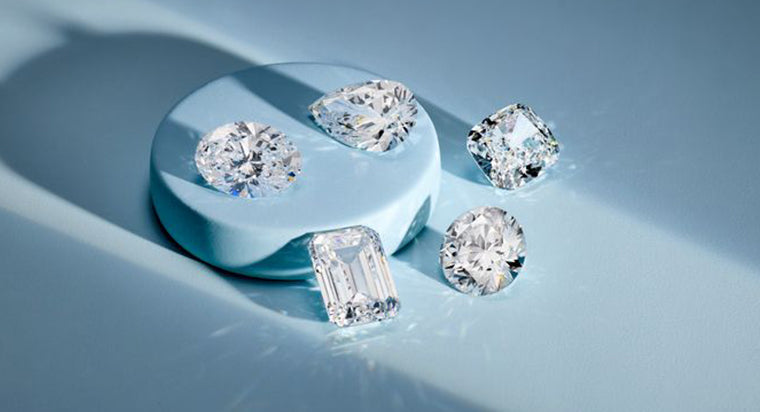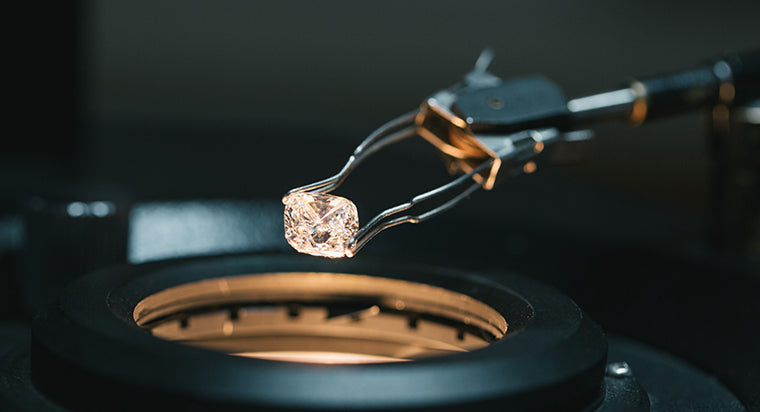SI Clarity Diamonds

Buying an engagement ring is all about priorities, also known as the four C's — cut, color, clarity and carat weight. Each of them should be selected in conjunction with the others. Doing so can give your budget some unexpected wiggle room. For example, if you're in love with a cut or color for your loose diamond that's slightly beyond your budget, you might be able to save a bit of money by dialing back slightly on clarity.
Diamond clarity — which runs on a scale from FL (flawless) to I (included) — is evaluated under 10x magnification to identify any tiny imperfections known as inclusions. When these inclusions are noticeable, that are graded as SI or slightly included. SI falls in the center of the clarity scale.
TABLE OF CONTENTS
What Does SI Mean in Diamonds?
SI means the diamond has small inclusions that are noticeable upon 10x magnification. They might be visible without any magnification, especially if they're larger or in the center of the diamond, where there aren't facets to camouflage them.
The SI range includes SI1 and SI2 (slightly included 1 and slightly included 2). An SI1 diamond has fewer, smaller, and less noticeable inclusions than an SI2. The size of the inclusions tends to be medium in nature, and the location can be anywhere (in the center under the table, or on the sides near the girdle). SI diamonds tend to have more centered inclusions. The number of SI2 and SI1 inclusions can vary. It can be a single inclusion or several. Typically, you can expect there is one grade-setting inclusion rather than many smaller ones.

Common SI1 Inclusions are:
- Cavity
- Chip
- Clouds
- Crystal (white or black)
- Feather
- Indented Natural
- Knot
- Needle
- Twinning Wisps
Because SI diamonds are below VS2 (or very slightly included 2), they can offer a good value to the budget-conscious purchaser. Less than 50% of all of the world's gem quality diamonds are in this range. An SI diamond can cost 10% to 20% less than a VS diamond. They're very much in demand, especially SI1, because the inclusions aren't outwardly obvious, and they allow consumers to optimize the other C's such as carat or color.
Clarity is one of the major 4 C's of diamond buying, in addition, to cut, color, and carat.
Watch our company founder help you assess which combination of the 4 C's will yield in the best diamond for your budget.
SI2 vs SI1: How Different are They?
Both SI2 and SI1 diamonds have inclusions that you might be able to see with the naked eye — some big, some small — and are visible on the center of the stone, or the sides, near the girdle. The biggest differences between SI2 vs SI1 diamonds are the number and type of inclusions they have. Read more about SI2 vs. SI1 Diamonds.
Is an SI1 Diamond Good?
Yes! Although an SI1 diamond isn't flawless, both SI diamond grades are beautiful and valuable. Most often, no one will come close enough to even see or identify inclusions. Like most other high-quality diamonds, SI diamonds will appreciate over time. To ensure this, it's advisable to have SI diamonds set carefully by experienced gemologists.
Popularity of SI Clarity Diamonds
SI diamonds are very popular because even though they may have clarity characteristics that are eye-visible, it’s not terribly distracting from sparkle. To the naked eye, diamond sparkle is slightly impacted and light performance is still quite high. Typically, only when the diamond grade is set by clouds or a single large inclusion, it can have a distracting impact. There are typically not structural problems that would cause chips or cracks in the diamond when set in jewelry, even if the inclusions are closer to the girdle.
Over time, consumer preference has shifted to diamond quality over sheer carat weight. We generally recommend not going below SI in clarity, especially with larger diamonds, because the imperfections get larger and are more likely to be seen. In smaller carat diamonds (below 0.50ct), SI inclusions will not be eye visible.
Searching for an SI Diamond
You can buy SI quality diamonds from a variety of jewelers. However, the types of SI diamonds may differ for each jeweler. This is particularly important as the imperfections may be better or worse, depending on the jeweler's inventory.
Using With Clarity's diamond search, you can find the largest inventory for diamonds with SI1 and SI2 clarity at the right price. Pair the clarity with the other diamond 4C's to identify if SI is the right clarity range for you given your price range and budget. Like everything else, the importance of clarity is entirely dependent on your personal taste.
The next range below SI is I (or included), meaning:
- The diamond may have obvious inclusions or imperfections that are clearly visible under 10x magnification.
- In larger diamonds above 0.5 ct, the diamond may have inclusions that are visible, and often without 10x magnification.
Lab Grown SI1 Diamonds
Whether natural or lab grown, all diamonds have some inclusions that make the diamond unique.
It is a misconception that all lab grown diamonds are flawless. While some may feel that lab grown diamonds will not have inclusions simply because they are grown inside a laboratory under controlled conditions, such is not the case. There are some inclusions that may occur with both the growing processes, whether HPHT (High-Pressure High Temperature) or even CVD (Chemical Vapor Deposition). Even with natural diamonds, some amount of inclusions may be a part of the diamond. But these inclusions may not be not visible to the naked eye. This is why SI clarity diamonds are in demand today. SI stands for Slightly Included which means that the diamond's inclusions cannot be seen with the unaided eye but are visible with 10x magnification.
While a lab grown diamond of SI clarity and a natural diamond of SI clarity both look the same, the only difference between them is the way they are sourced. A natural diamond is mined from the earth, whereas the lab grown diamond is 'grown' inside a lab. Both these types of diamonds are then graded in a similar manner on a clarity scale based on the number and type of inclusions as seen by a gemologist. While our natural diamonds of an SI grade come with a GIA certificate, lab grown diamonds that have an SI clarity come with an IGI certificate.
At With Clarity, we ensure that all our diamonds are certified to offer the buyer peace of mind.
While SI clarity diamonds do have inclusions, they make for a great value purchase. They are usually 'eye clean' as discussed. But in the case of some diamonds that are not 'eye clean', watch out for clouds, feathers, and crystals and spend an extra minute to see whether it impacts the diamond you are considering. While looking at average price points, a round shape, H color, SI clarity, and a 1-carat-sized natural diamond could cost around $4500 and the same in a lab grown variant would be around $1500.
It is always advisable to work with a gemologist to guide you get the right value and right quality.
Working with an Expert is Always a Good Way to Go
If you want to invest in SI diamond, it's best to work with a gemologist who can help you find the best stone with the fewest inclusions. An expert gemologist can also help you pick a diamond engagement ring setting that will help mask any inclusions, ensuring only the beauty of your stone is apparent.
Interested in an SI diamond but don't know where to start? Fill out the short form below, and we'll have our experts hunt down three personalized diamond suggestions that fit your tastes and budget. Like one? Wonderful! We'll talk more. None of them fit? Tell us. Our experts want you to be happy, and they won't rest until they find your perfect fit.
FAQs
What does SI Clarity mean for a diamond?
Is SI Clarity good for a diamond?
What is the best clarity for a diamond engagement ring?
What is the most affordable clarity for a diamond engagement ring?









